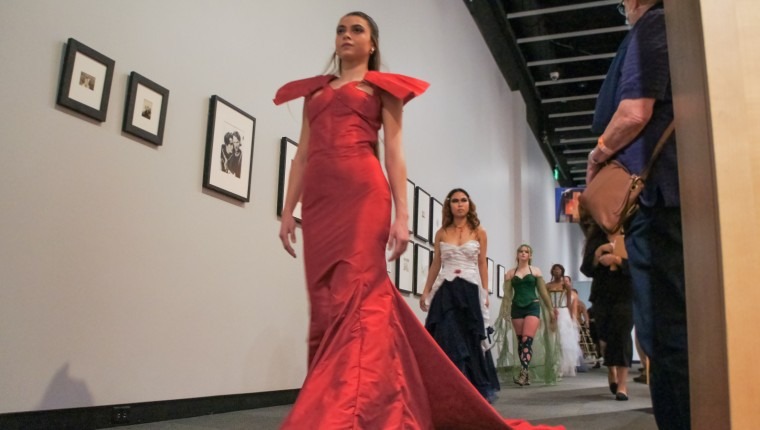and Design at the Dalí
Runway Show
February 24 from 6-8 pm
Gibbs High School, St Pete
Details here
also on view
February 28 – March 17
Florida CraftArt, St Pete
Details here
and
Accessible Online
Ongoing
The Dalí Museum invites creative teens each year to learn the intricate art of fashion design – and runway presentation – while creating work inspired by Salvador Dalí.
We’re privileged to celebrate the creativity of these young designers.

These emerging artists share their thoughtful analysis of works in the Dalí’s permanent collection – and beautifully describe their adventurous designs, their careful focus on sustainability and repurposing materials, and the painstaking time and skills it took to translate ideas into wearable art.
This year’s theme, Eleg-ants: Designs from Dalí’s Animal Kingdom, challenged students to create concepts that draw from the animals, insects and sea creatures in Dalí’s artwork.
You can view these designs paired with Salvador Dalí’s originals on the Dalí website.

Dana Alkhouli
The Discovery of America by Christopher Columbus, 1958-59
H.B. Plant High School, Tampa
Grade 12
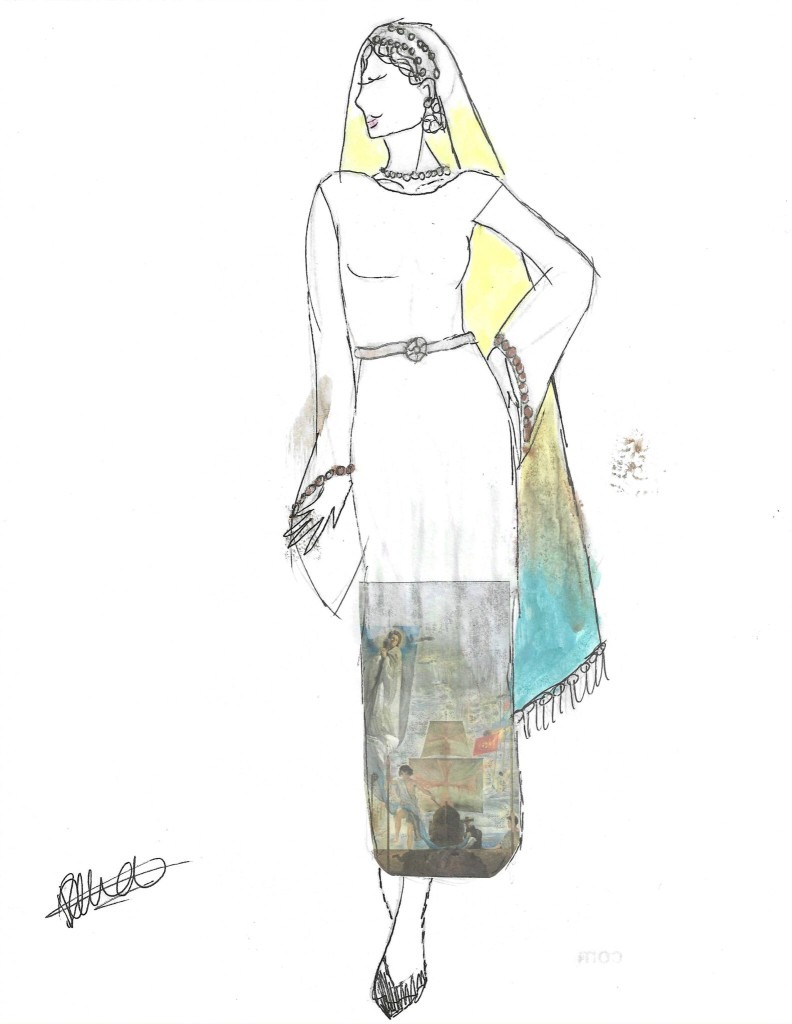
I chose the Sea Urchin because this animal is a symbol of Dalí’s Spanish culture and identity. My piece adds sea urchin beads to the dress and ties-in elements of Spanish culture, religion and history, as Dalí does in his painting Discovery of America.
My materials are cotton, calico and recycled fabric.
I start off by sketching out what I want to make, then making multiple drafts. Once I’m happy with a draft, I start to make the pattern. Normally I take a ready-made pattern and adjust it – then when the pattern is cut I paint and add color. Then I sew the pieces all together and add the details.
Ryan Bishop
Dinner in the Desert Lit by Burning Giraffes, 1937
St. Petersburg High School
Grade 12
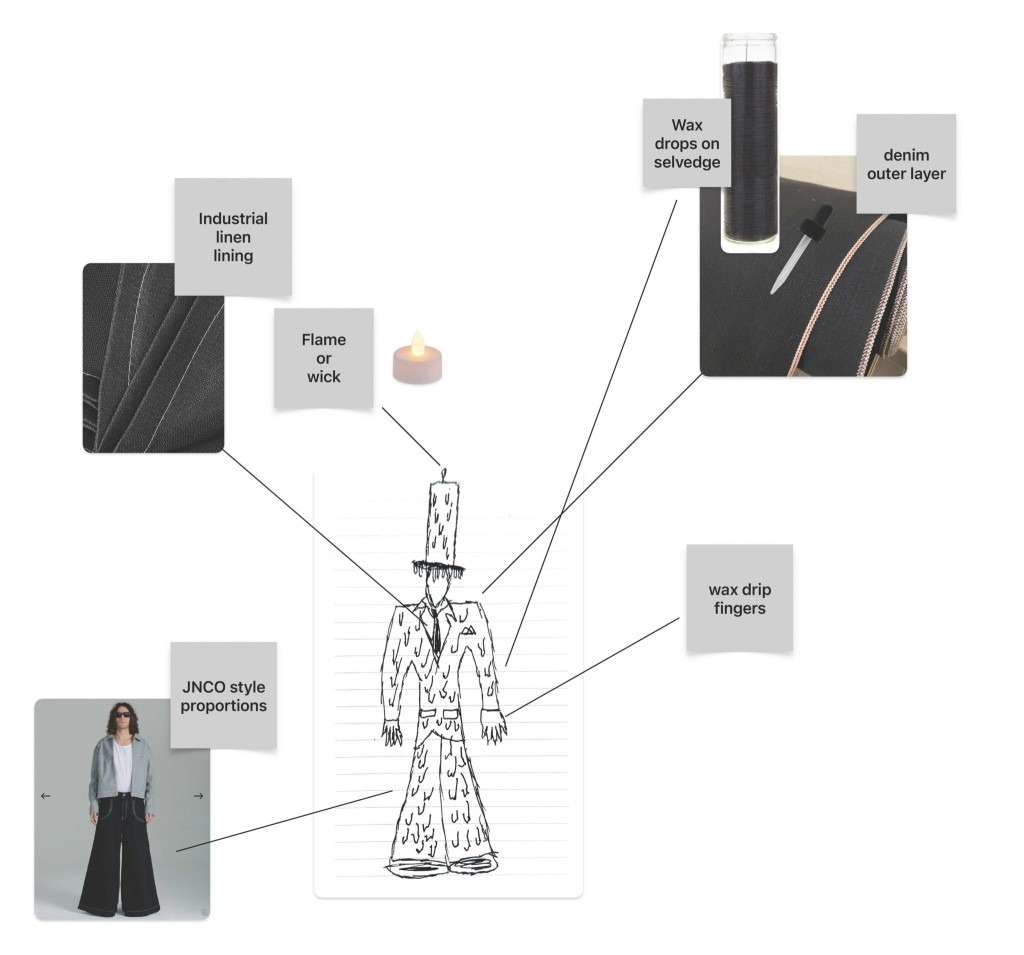
I chose the Giraffe because I like the Dalí piece behind it. In Dinner in the Desert Lit by Burning Giraffes, there are elements of formal wear that I believed could be well represented by my design style.
I also like that Dalí’s artwork is charcoal, as I predominantly use black in my designs.
My work is a formal outfit that incorporates elements of melting wax and stretched proportions. The tall top hat symbolizes the long neck of the giraffe and pairs well with the subtle leaflets of fabric throughout to show off the leaves giraffes eat.
The melted wax symbolizes the burning element of the giraffes and shows off the concept of being slowly worn down over time.
For this design, I used a mixture of linen and cotton, with selvedge denim that was sourced from a previous project.
I incorporated dripping wax throughout my design in order to add layered textures and create a connection with Dalí’s work.
When planning for this look, I took inspiration from Dalí’s heavy use of the color black, and his depictions of open flames in his works. I thought this idea could be represented by melting wax – and would be a safer way to add nuance and texture to my pieces.
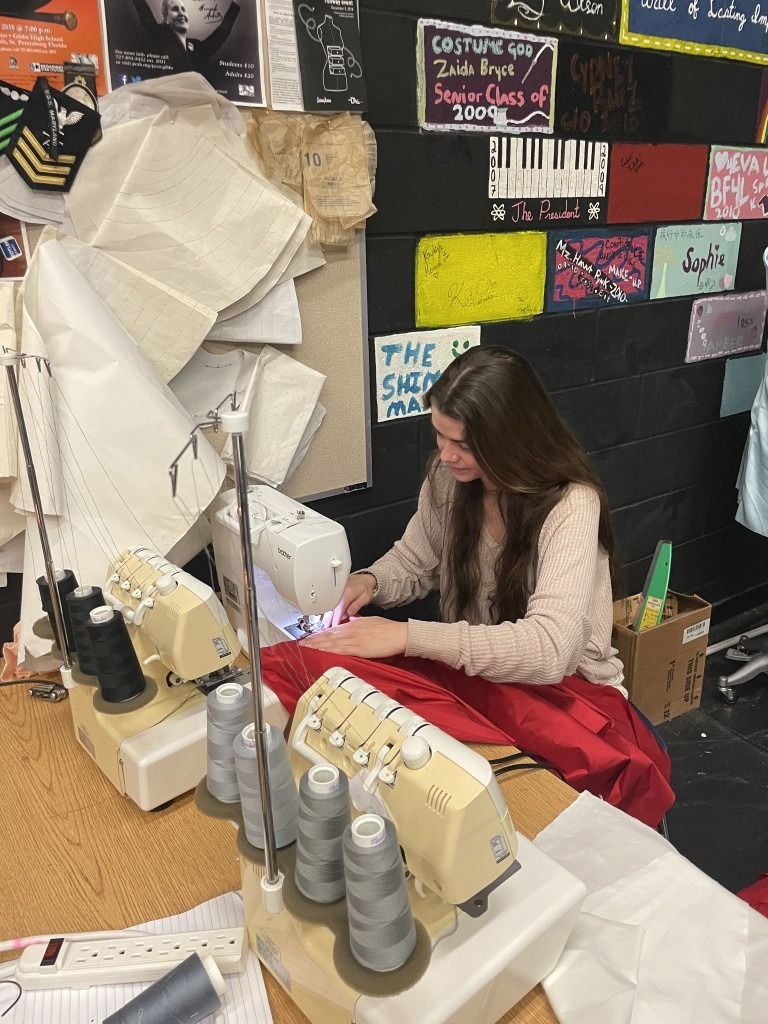
. . .
Sophia Conley
Hannibal Crossing the Alps, 1970
Pinellas County Center for the Arts at Gibbs High School, St. Pete
Grade 10
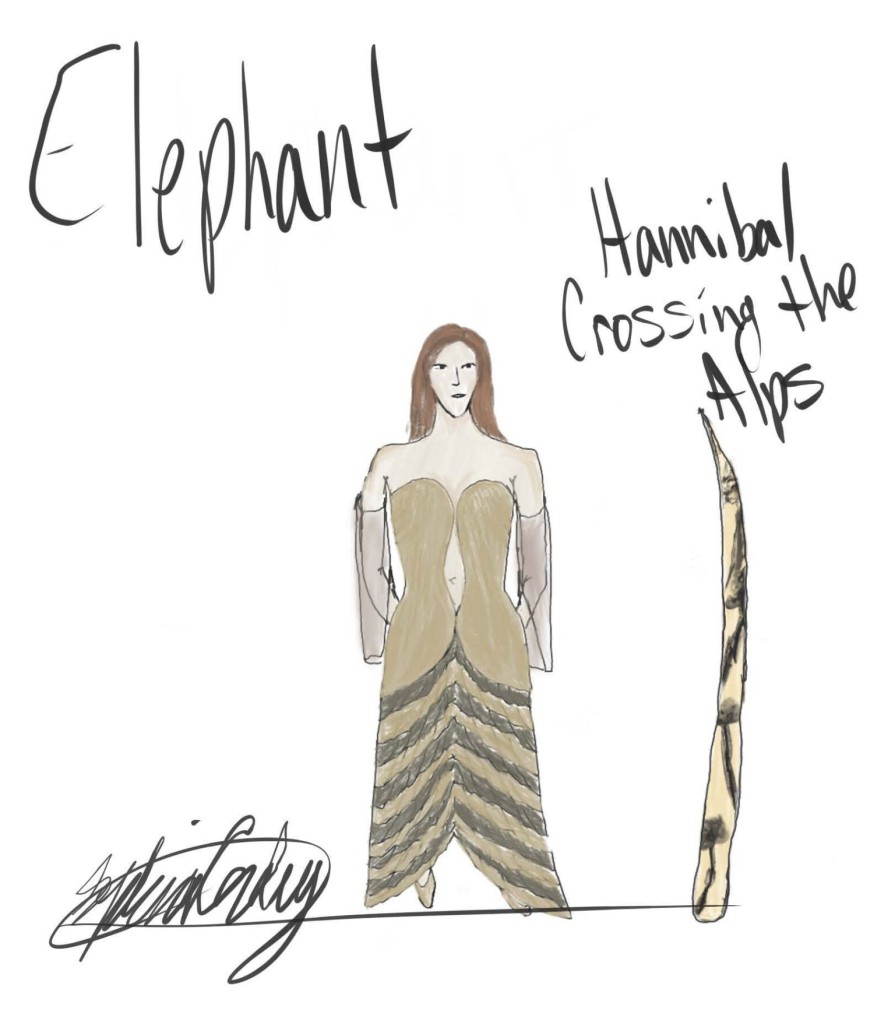
I chose Elephant for my animal because I’ve always loved how majestic and strong they appear.
Another reason is that I love working with different textures and I believed choosing the elephant would allow me creative freedom in that area.
My piece connects to my animal and Dalí’s work through the use of textures and different textiles to emulate its skin, wrinkles and body parts.
In terms of connecting to the painting, Hannibal Crossing the Alps, I’ve chosen to take the beautiful color palette of the painting and apply it to my piece.
I’ve also chosen to use the element of movement from the painting with the inclusion of a walking stick.
I chose denim for the bodice and the majority of the skirt to imitate an elephant’s rough skin texture.
As you go further down the dress, I chose to gather the layers in order to emulate the wrinkles and movement of the elephant. I also made a walking stick that resembles an elephant’s tusk with hand-painted details and anti-poaching and pro-wildlife insignia in a style similar to scrimshaw.
At the beginning, all I knew is I wanted to use denim – and from there I found my concept of using two rearing elephants back to back.
This is shown by using an elephant’s ears for the bodice, sleeves as the trunks, and the gathering as the wrinkles of the animal.
The color palate emulates the neutrals of the painting. I also took the use of walking sticks or spears in the painting and decided to create my own.
Emily DeLucia
The Ram, 1928
Lakewood High School, St. Pete
Grade 12
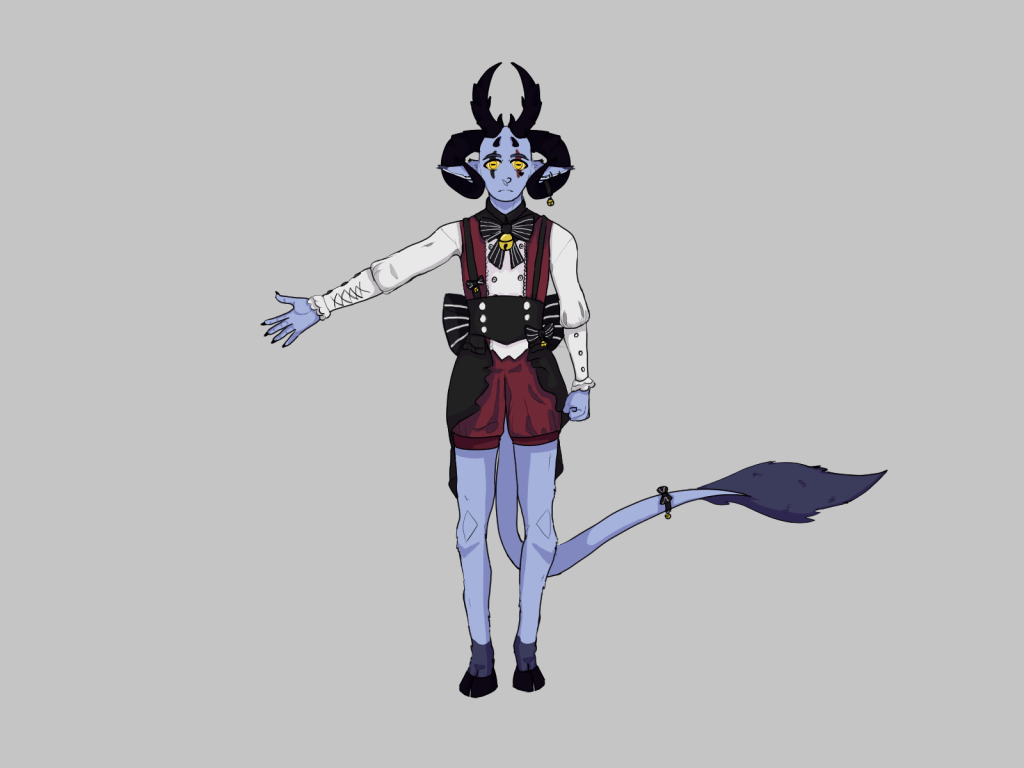
I chose the Ram because I enjoy the diverse ways rams can be interpreted besides just their face value. Plus, their horns, eyes and hooves inspired me.
There is a lot of mistaken identity between rams and demons, which also happened to another animal in one of Dalí’s paintings. In his work Portrait of My Dead Brother, the vulture from the story the painting is inspired by is shown as a blackbird.
This mistaken identity is one of the reasons I wanted to make a more ‘demonic’-inspired outfit.
As a beginner, I was advised to buy clothes and make them my own instead of working from scratch. I used thrifted clothing, fake fur, 3D-printed hooves, wire and foam.
I decided to work on the shorts first, which would then lead to the shirt and waistband. After that, I worked on the legs, shoes, horns – and finally, gloves.

. . .
Sam DeLucia
Head of Donkey, 1936
Lakewood High School, St. Pete
Grade 12
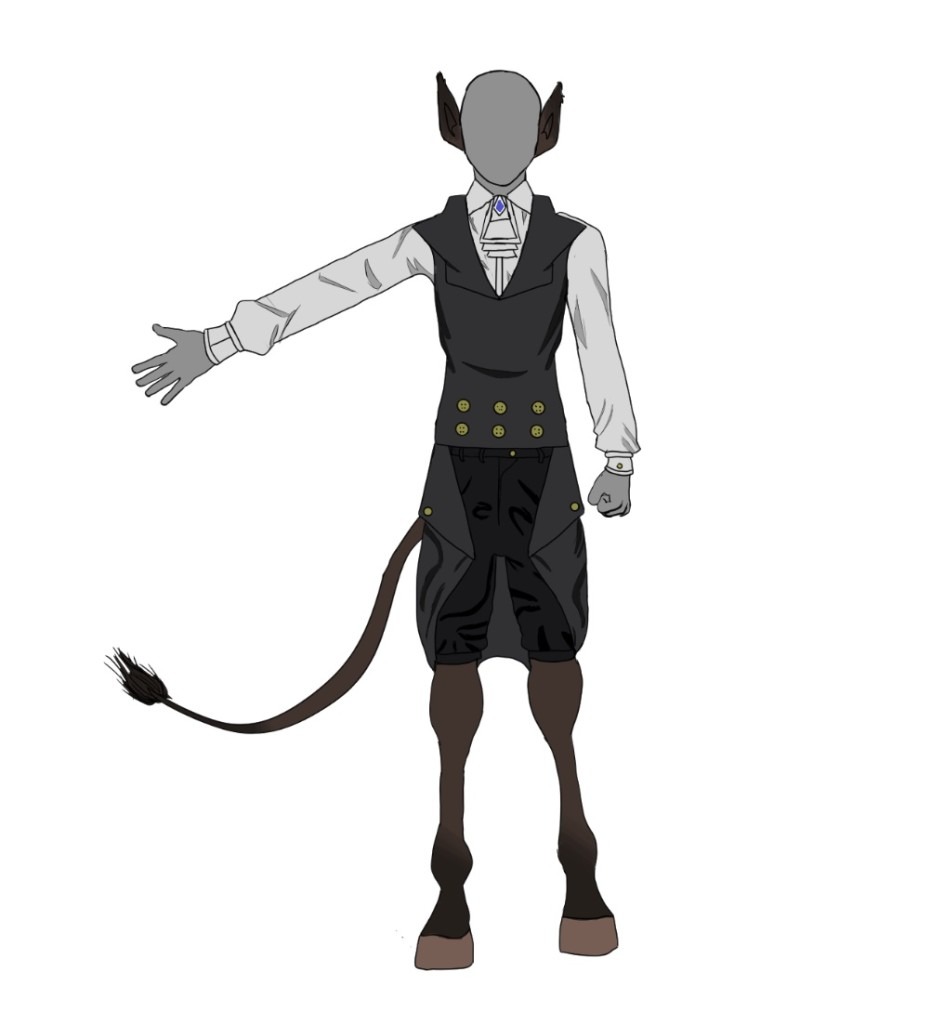
I chose the Donkey because of its connection to mythology. One of the myths of King Minos references a donkey.
My piece connects to Dalí’s Head of Donkey because of the literal donkey features and the Rorschach aspects. I chose to create a formal look inspired by a picture of Hermann Rorschach.
My materials include thrifted clothing which has been adjusted to fit my design, fake fur and 3D-printed hooves.
Starting with the pants, I worked my way up to the jacket, while in my spare time finishing the ears, legs and tail.
Melina DiGiorgio
Telephone in a Dish with Three Grilled Sardines
at the End of September, 1939
Howard W. Blake High School, Tampa
Grade 11
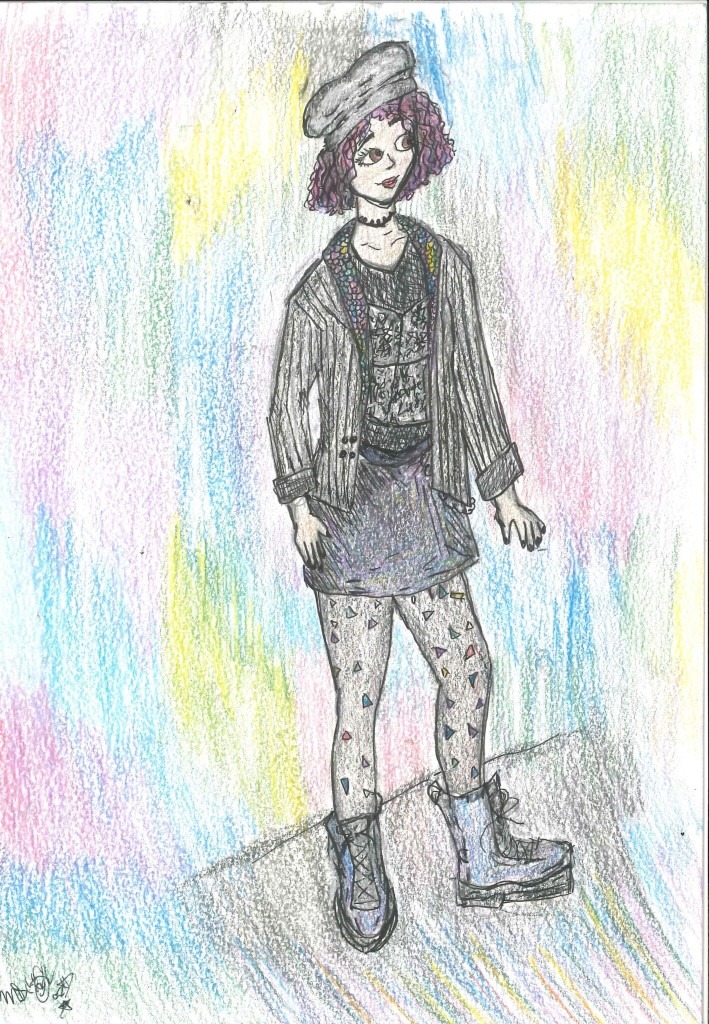
I chose Sardines as my animal because I’m intrigued by their political significance in the painting. They represent changing ideals in the world at the time and the effect of rapidly progressing technology that fails to actually solve any issue.
As the story goes, Dalí found himself haunted by the phone calls of Adolf Hitler and Neville Chamberlain, and their war negotiations. The sardines represent the basic meal of a Spaniard, which in turn represent what those calls meant for the world – and the new-found ease of lying and deceit through technology.
I also picked sardines for the iridescent shine on top of their black and grey coloring. I thought this look could be well-shown as a design and that the color scheme would work well with what I was hoping to accomplish.
I also find the smooth shimmer of the sardine and the mood of the painting have a dark effect that I love to emulate.
My design connects to Dalí’s work through the Punk and Beat roots I included to better showcase the counterculture and a sense of faux apoliticism in Dalí’s art and personal life, as well as his shifting political viewpoints.
I added industrial-themed parts to connect the sardines to immigration and factory work.
I used many materials I thrifted from Goodwill, and took apart other clothes to get the fabric color I wanted. I also found pieces in my own closet that I saw potential in for redesign and material, and purchased fabric and a pattern from Joann Fabrics, using the discount provided by the program.
There were many things I took apart to repurpose and redesign. I wanted to upcycle and make new pieces – incorporating lace, nylon, cotton polyester and sequins to give fresh looks to older items.
My process has been a combination of spontaneity and proactive time management.
I find influence from my favorite music and books, especially ones with stories of wartime and economic distress. I find this helps me better comprehend what it meant to be an artist at the time of Dalí.
I looked through various forms of protest media and rebellion through systems of class rulings and money. I also went through many fashion books to understand the subcultures of the ’60s, ’70s and ’80s. These help to inspire me in the clothing that I wear and design – and to gain new perspective as to what choices were made and why.
Kate Evans
Seven Flies (and a Model), 1954
Pinellas County Center for the Arts at Gibbs High School, St. Pete
Grade 12
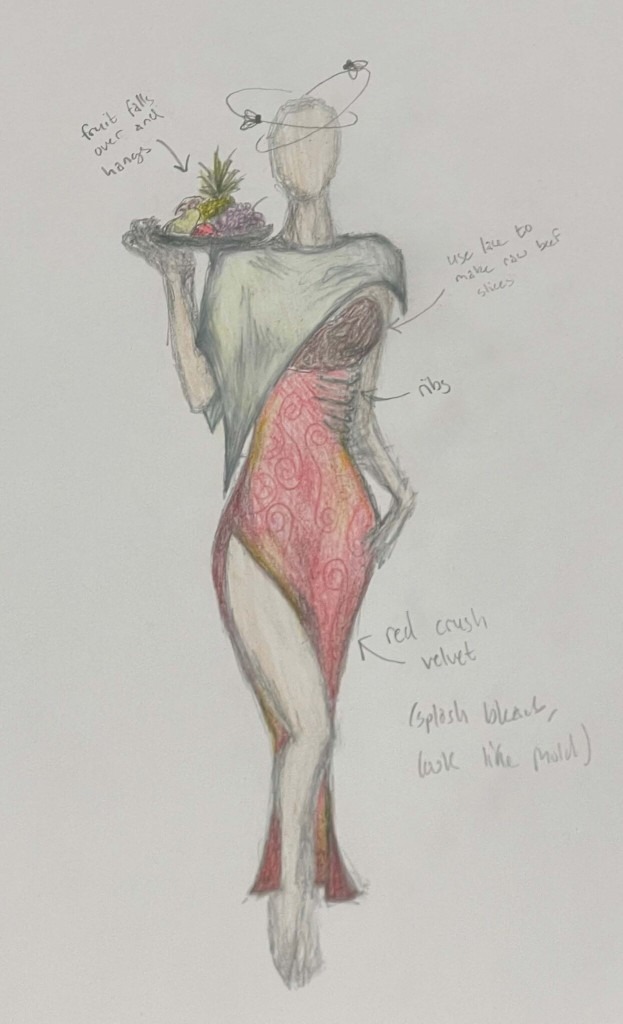
I chose the Fly as my animal because of its symbolism between life and death. Sometimes when I think of flies I imagine them feasting on lush bowls of fruit or flying through gardens with beautiful flowers and crisp vegetables. Other times I imagine them swarming around decaying carcasses and rotting meat.
I wanted my piece to reflect the idea that between life and death, rich and poor, young and old, beauty and disgust, flies are inevitable.
So far my dress has been made completely out of a single tablecloth that I got from Goodwill. I plan to sew feathers around the waist which I have accumulated over the past few weeks from my pet chickens.
My process has been primarily draping. To cut down on waste as well as time, I have been draping with my actual fabric instead of making pattern pieces. This gives me a lot less room for mistakes, but it pushes me to be more cautious and intentional with my design.

Angelica Genetiano
The Sheep, 1942
Boca Ciega High School, Gulfport
Grade 12
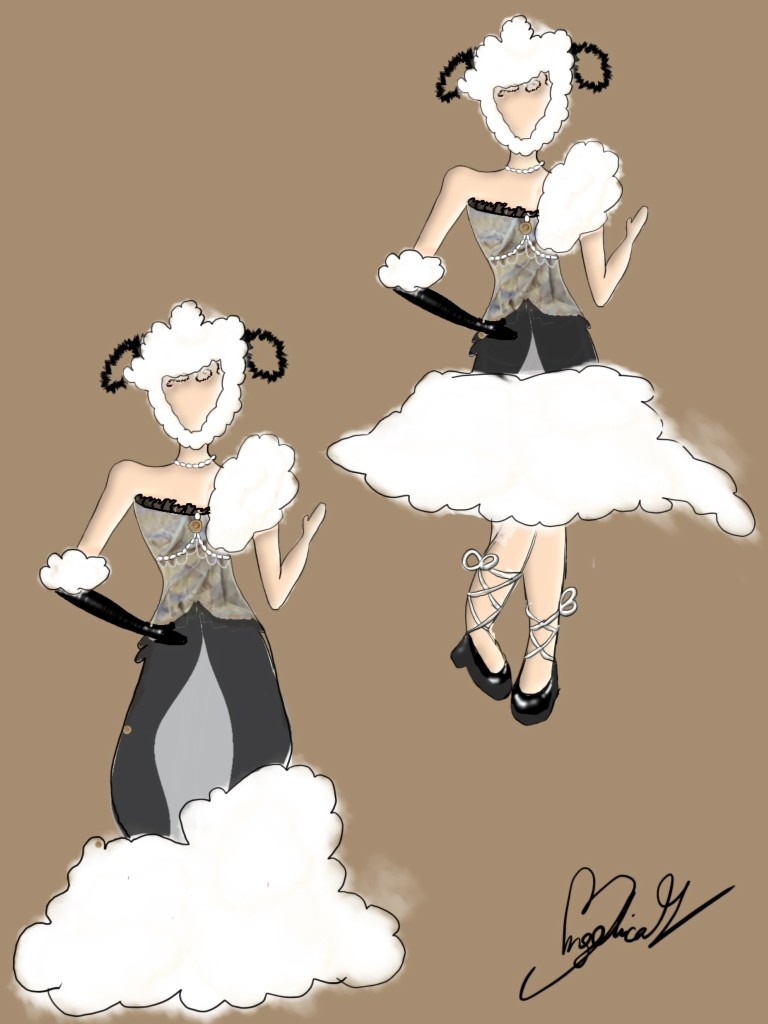
I really like Sheep as they are very fluffy, and during the animal selection process, I saw wool on the free fabrics we could use.
My piece connects to Dalí’s work by being transformative. It transforms from a mini dress with a fluffy bottom to a long dress.
I got inspired by Dalí’s painting The Sheep, as it is an overlay. In other words, it was originally a sheep painting that he painted over.
This work was done during the 1940s, a time when Dalí was collaborating with Coco Chanel, so I incorporated pearls and the color black, as those were elements Chanel was known for.
Then I used wool on parts, and pillows on the bottom of the skirt to signify the sheep — this pillow is inspired by “counting sheep” before falling asleep.
The hat I used for my design is a repurposed bunny hat that I had in my closet. The top layer of my corset is from a curtain I got from Goodwill, and the plush is from my old stuffed toys.
I removed the seams of the curtain I got from Goodwill and used the decorative part for my corset. Then with the help of Ms. Donnelly, I cut out patterns and pinned the fabric and cut it.
For my hat, I removed the seams of my bunny hat, took off the ears, and used the fabric from the ears to cover the bunny’s face. I then cut and stitched the bunny hat to make it shorter on the side, so it’s a perfect fit for my head.
With the leftover scrap fabric, I cut two equal-in-length rectangles and sewed them together and put plush in them. I then used the wool to add more sheep to my piece, on the sleeve.
I repeated this process but used a shorter rectangle to add the fluff design for my gloves and then a bigger rectangle piece for the fluffy bottom of my skirt.
I used a pattern from Joann Fabrics to create my skirt – the fabric is a mixture of donated fabrics and fabrics I got from Goodwill.
Gracie Haas
The Font, 1930
H.B. Plant High School, Tampa
Grade 10
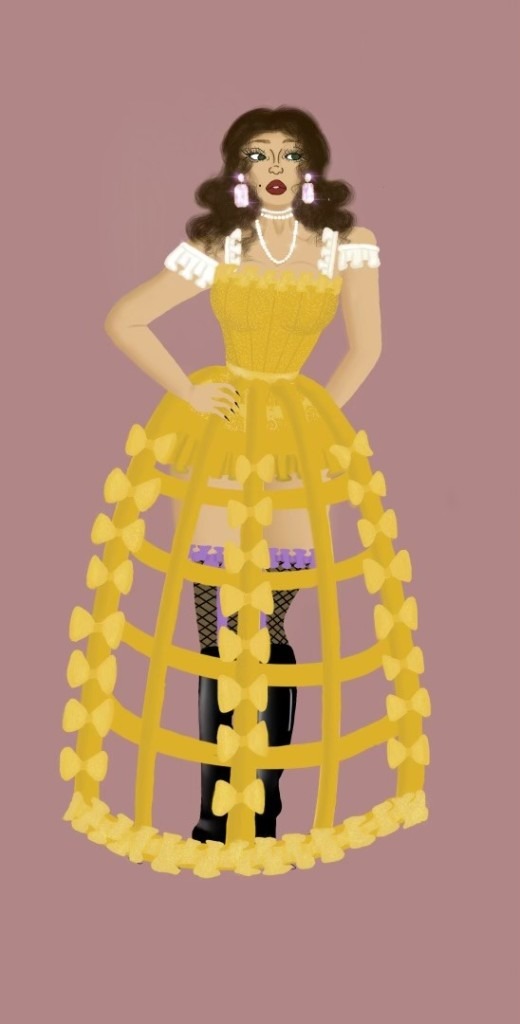
I specifically chose the Lion for several reasons. One of the main reasons is because the lion symbolizes empowerment, which is something I deeply value in my life and as a woman.
My piece connects to Dalí’s work because of the historical side of the design. My piece strongly connects to the historical fashion of 1700s Spain, where Dalí was from – specifically the queens of Spain, including Queen Isabella Farnese and Queen Mariana Victoria.
The gold on my design strongly represents the mercantilism periods of Spain, when their economy was mainly based on gold exported from the New World.
My materials include satin, cotton, tulle and lace fabric. Most of my design has been recycled from something I’ve previously worn or that I’ve gotten from thrifting at places like Goodwill or Salvation Army.
My process was very planned out — I wanted everything done in sections. The first thing I worked on was the corset top, which I had previously used in a costume a year prior.
To make it fit this design, I added some trim and I painted a beautiful swirl pattern on the corset. For the swirl patterns, I attempted to add some inspiration from Vincent Van Gogh’s piece titled The Starry Night (1889), as Dalí was very fond of his work.
I then began working on the skirt portion and determining how I would tie it into and fit it perfectly with the top. I did lots of research during my process on Spanish monarchs in the historical era of the 1700s.
My process was especially long when it came to sewing — I pride myself on the fact that I sew almost everything by hand, while most use a sewing machine. And while this may take me longer, I believe it further connects me with my work.

Lucy Haura
Apparatus and Hand, 1927
Tampa Preparatory School
Grade 11
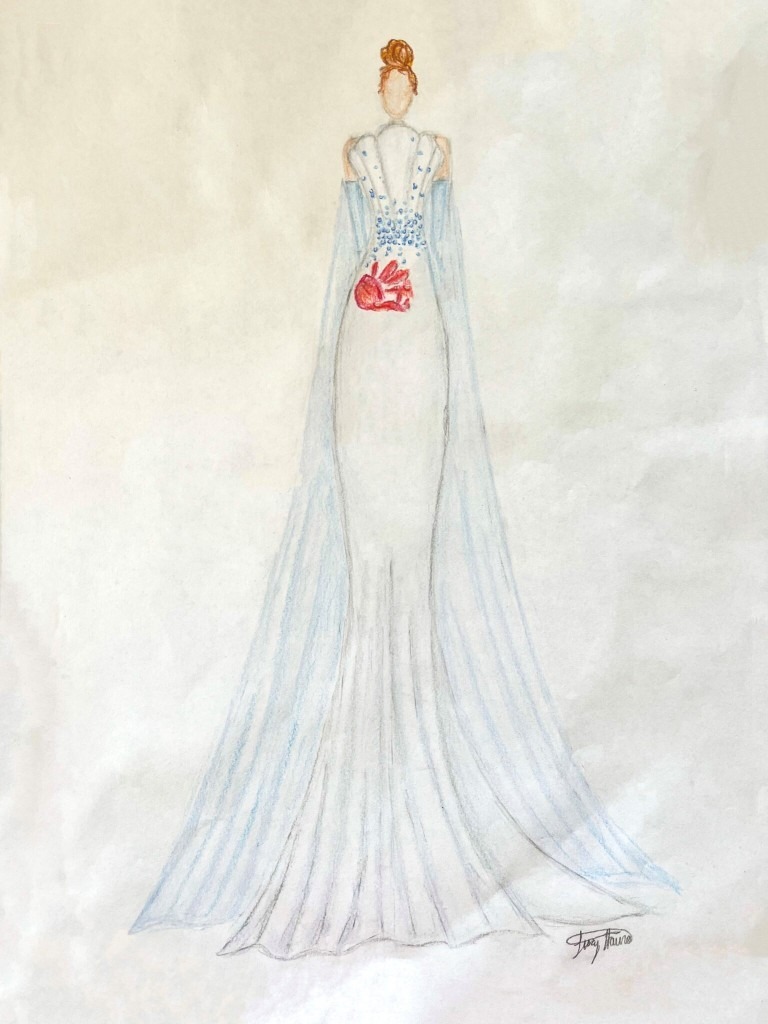
I chose Fish as my animal and Apparatus and Hand (1927) as the Dalían piece. I chose this work by Dalí because I really like how the colors work together and I wanted to combine structure and softness in my piece.
I chose to have fish as my animal because I really enjoy working with fancy fabrics and embellishments. I wanted to use sequins, rhinestones and other notions to bring sparkle and detail into my design.
To me, my design draws inspiration from Dalí by demonstrating fear. Dalí painted Apparatus and Hand to represent his fear of intimate contact with women. I wanted my design to symbolize how you can have a strong front and appearance – yet everyone fears something.
The dress is a structured piece with lots of boning, embellishments and drama to draw your eye. However, there is a big red handprint showing fear and demonstrating that fear is present and impactful for everyone.
This is further shown with the fish, represented by the large amount of beads and sequins on the bodice who live in a school to frighten and prevent predators from attacking. In this way, they put up a powerful, intimidating front.
However, individually, they are fragile animals – which I convey quite literally within my design with the “fish” being shiny bits of plastic sequins and glass beads.
My design was created out of white matte satin from Joann Fabrics to make the dress, some blue chiffon I already had at home for the cape in the back, and a mix of rhinestones, pearls and sequins that I either already had or purchased.
I also used scrap white fabric from my house to line the bodice and extra interfacing and boning to give it structure.
My process started by drafting a pattern on my dress from some scrap fabric I had. I tried to create a seashell neckline to bring in some of the fish’s environment. It had a large, scalloped edge and a low back.
I sewed it together, fit it to myself, and created the lining, interlining, and exterior. I also sewed boning channels into the lining.
Ms. Donnelly helped me find a pattern for the skirt – I wanted a more fitted skirt at the top and a soft drape at the bottom with a slight train. I also cut that out of the matte satin — the beading on the bodice took a very long time. I used the at-home sessions to bead while watching shows and movies during the break.
For the skirt, I tried creating a bias-cut for the first time – at a 45-degree angle so that it would have a nice drape. I also had to figure out insert a zipper into a bias cut.
I also got a lot of practice with embellishments – I used many different types, like hand-sewing sequins and pearl beads and using fabric glue to attach rhinestones. I had to learn how to sew the bodice while working around sequins and other embellishments that could get in the way of the machine.
Chau Huynh
The Language of the Bird, 1950
Hollins High School, St Pete
Grade 12
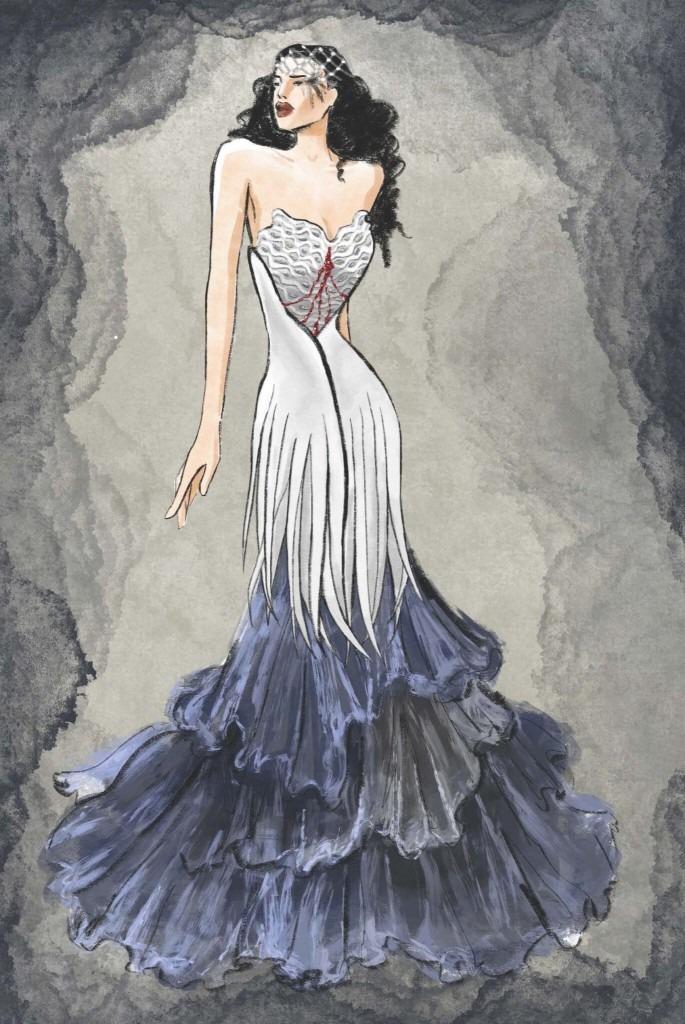
Swans are versatile creatures, present in many different pre-existing, notorious cultural works. For instance, Swan Lake by Pyotr Ilyich Tchaikovsky, Leda and the Swan by William Butler Yeats, and more recently, the movie Black Swan. The potential cultural references were a big factor in my selection of a Swan.
Additionally, the Dalí artwork itself – The Language of the Bird – is very dramatic and beautiful, so naturally it was also my favorite from the Dalí Museum’s recent sketch exhibit.
Rather than my design being purely animalistic, I wanted to stick with the themes presented in the painting and explore contrasting ideas of good and evil.
Language of the Birds was based on the infamous Divine Comedy by Dante Alighieri. In this section, the main character speaks to the Justice Eagle, asking it what the decisive factor is between what heaven and hell are for nonbelievers. The eagle explains that justice is a concept beyond human understanding.
This is interesting because Dalí remained unreligious for the majority of his early career. However, in the 1940s Dalí began exploring his faith and even met with Pope Pius XII in 1949. This painting was created in 1950, so theoretically it could represent his interpretation of Catholicism.
In regard to his depiction of a swan, Dalí previously depicted his mother in the manner of Leda from Greek mythology. I believe that unlike pop culture’s association of swans with innocence and purity, Dalí views them as more of a mischievous character. In this sense, this painting represents Dalí’s possible regrets about his earlier atheism – believing he is like the swan, too far gone for any justice.
I used fabric I got from my aunt, an old wedding dress from my friend’s mom, and various scraps from Goodwill through the program’s vouchers.
I also bought fabric dyes for the Goodwill fabrics. But unfortunately, due to my lack of research, I discovered that polyester does not dye well and three bottles of dye later, the fabrics remained the same, only a little more washed out.
Now in my second year in the program, I knew I wanted to try fabric manipulation through smocking techniques, as I’ve seen on social media. I also wanted to do some kind of onstage transformation to go with the themes of good and evil.
My only regret with this program is not having done it sooner. After last year’s program concluded, I had found my passion. Being able to actually go through the process as a designer, I realized that this is something I really enjoy doing and wouldn’t mind giving it my all.

Delaney Kelly
The Ants, c. 1936
Pinellas County Center for the Arts at Gibbs High School, St Pete
Grade 11
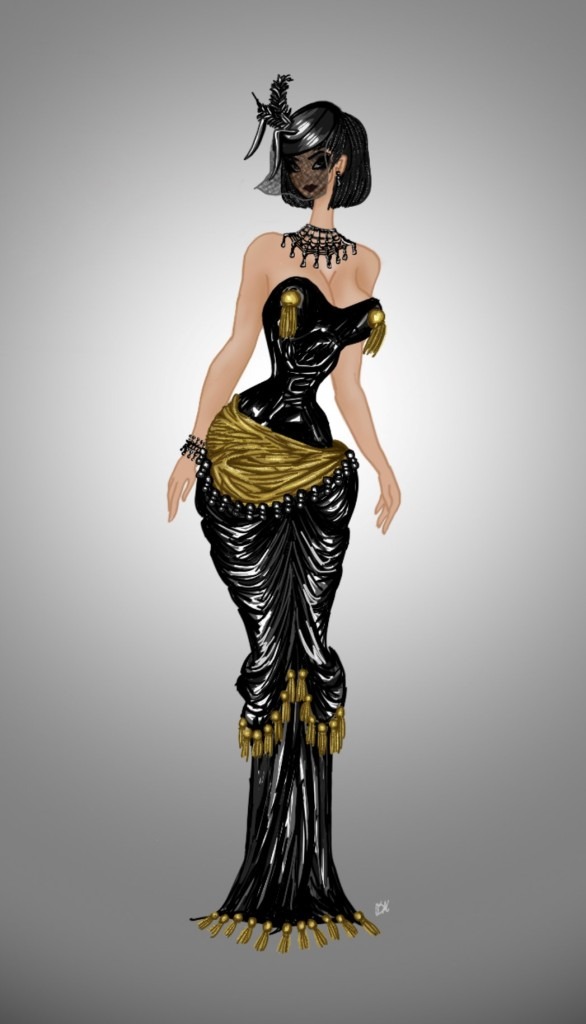
Dalí’s fascination with Ants in his paintings intrigues me, leading me to explore their symbolism. Ants, often associated with death in Dalí’s art, provided a unique departure from the mammal and bird focus commonly seen in fashion.
The vast number of interpretations of death in fashion design slightly intimidated me. Drawing parallels between Dalí’s use of ants as a symbol for death and Victorian funeral attire, I found inspiration in the ants’ abdomens, reminiscent of a late 19th-century bustle.
It’s the transformative power of makeup that I discovered in middle school that’s become my greatest passion — I aim to infuse both aspects into my piece.
In my garment, I convey the stark contrast seen in the painting The Ants by using black fabric as the dominant element accentuated by gold. While inspired by traditional wear, I added my own twist to infuse modernity into the Victorian aesthetic.
To realize my vision, I opted for classic satin to maintain focus on the garment’s construction. I used assorted thrifted black fabrics to add extra details, while a crimped gold fabric and gold tassel trim introduce striking contrast and visual interest.
After navigating the complexity of my design, I strategically simplified my process by using a pattern for the skirt, reversed for a unique touch. Sculpting the bodice and meticulously hand-sewing details were the challenging yet rewarding aspects of the process.
Participating in this program revealed the beauty of diverse perspectives. Sharing my ideas and hearing others’ unique concepts reinforced the individuality of creativity. This program empowers us to embrace our quirks and express ourselves in ways we might not have considered before, fostering a creative environment where we can all thrive.

. . .
Elsa Kusek
Illustration for Tres Picos, 1955
Pinellas County Center for the Arts at Gibbs High School, St Pete
Grade 11
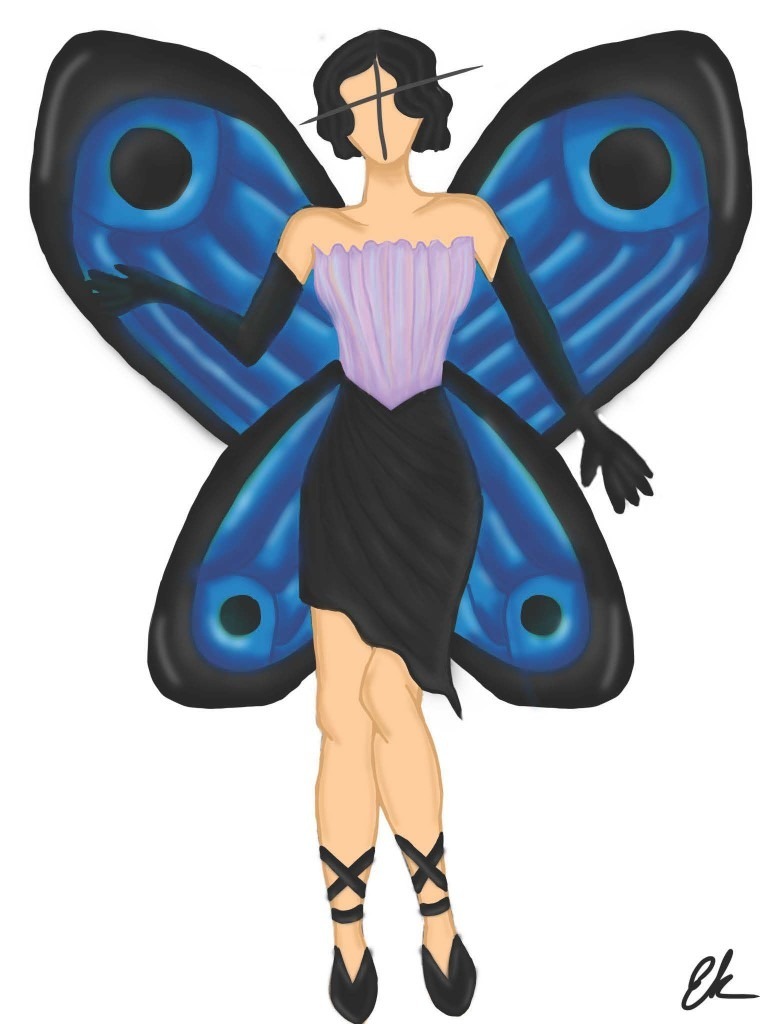
I chose the Butterfly as my animal because of their overall beauty and their connection to Dalí. There are so many variations of this wonderful creature and it has really allowed me to experiment.
To Dalí, butterflies meant change, hope and freedom. He had a great appreciation for their beauty, which I did my best to display in my design.
The painting by Dalí that displays butterflies and inspired my work is called Tres Picos. While in the design process, I made sure to connect colors from the work and to use similar shapes, like the main butterfly in the background as inspiration for my design.
So far, I have not paid for any of my material I’ve used and plan on acquiring anything else I need without spending any money. Everything is secondhand – the bodice is made from donated fabric, the skirt was transformed from old clothes and the wings were hand dyed and structured with wires.
It was very important to me to use what I had around me in order to keep this piece as sustainable as possible.
Throughout this process, I’ve used many new techniques, like pleating for the bodice and draping for the skirt. My biggest challenge has been the butterfly wings, and finding ways to structure them. I am using foam sheets and construction wire to create the wings and everything else is pretty much draping.
Libby Lewis
Portrait of My Dead Brother, 1963
H.B. Plant High School, Tampa
Grade 11
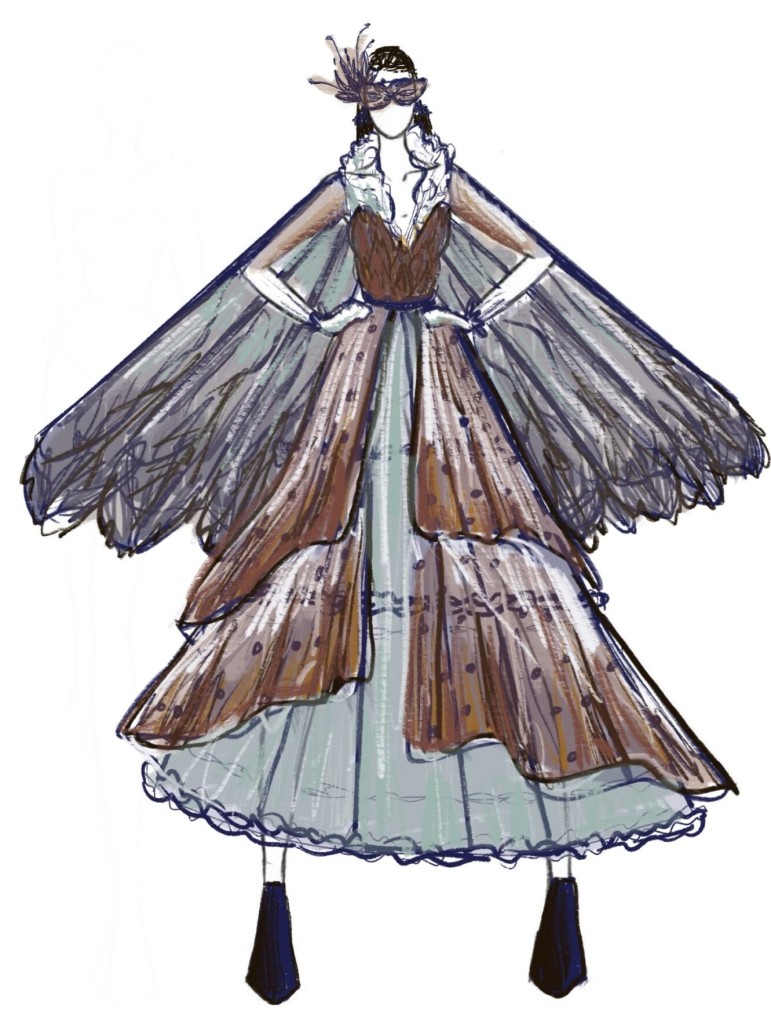
Vultures are typically regarded as disturbing animals that survive off of dead things, in our society. I wanted to take a traditionally dark and mysterious creature and showcase its beauty in order to break any negative connotations. Vultures play such a vital role in the creation of life because when they consume carcasses, they eliminate possible pathogens that could harm other organisms.
One of the main things I think about as a designer is how I can take technical aspects and incorporate them into my art. While brainstorming, I constructed a folding fan on a larger scale to function as the wings.
My work alludes to the myth of Castor and Pollux – a set of male twins born from an egg, one mortal and the other immortal. Dalí felt a connection to this story because of the loss of his own brother before he was born. Close in age and named Salvador after his deceased sibling, Dalí saw himself as immortal and his past brother as mortal.
While this ideology can be seen throughout my garment through the vulture influence, I also took this story to compare the innocence of youth – shown in the white feathered collar, just like a baby vulture – with the wisdom of an adult, represented by Dalí himself.
In his youth, Dalí built a life his parents could be proud of and was able to discover and learn – not only for himself, but for his brother. My outfit connects to this by contrasting the dainty, feather collar of youth and the structured, developed wing-like cape.
Inspired by the vulture, I am using materials that I have ‘scavenged’, yarn scraps, thrifted curtains that I sourced from previous projects, donations from the Dalí, friends and family, and thrift stores.
I’m focusing on texture this year and incorporating new ways to elevate my outfit through textiles by combining punch needling, crochet, pattern making, and lots of layers.
While most of my material is used from the same thrifted curtains as last year’s outfit, I added new techniques to elevate my design. By including a hoop skirt (which I made from pex tube), folding fan-type wings, and a wire-based neck piece (which I collected from our shed), my design can be seen as a garment ready to walk the gala.
As soon as I received my animal, I set up a mood board to have a physical idea of how my vision could come to life. I researched more about the behavior of vultures, different types, and how it could relate back to Dalí’s work.
After finishing my rendering, I sourced my materials and began working. Watching YouTube tutorials, asking lots of questions, and through much trial and error, I was able to create my final design.
I knew that I wanted to incorporate the powerful essence of a vulture by adding wings, while still keeping the elegant look of runway fashion. By adding the dotted pattern seen throughout Dalí’s work as well as the ominous color scheme there is a cohesive effect that ties the final design together.
I’m now in my third year of the program, and as always — and more than anything — I have seen how the people of this community have made it such a special experience because of their dedication to creating new ideas to share with everyone and pushing me further than I think I can go.
Because of this, I’ve tested the limits for what materials can be used as fashion – and have learned that there are none.

Texys Mahaffey
The Ecumenical Council, 1960
Shorecrest Preparatory School, St Pete
Grade 12

I chose the Octopus as my animal because I had instant inspiration due to their tentacles and the overall fluidity I could connect to my design. Octopuses have an elegance within the water that I wanted to express through fashion.
My piece connects to the octopus and Dalí’s work by utilizing the colors of his painting The Ecumenical Council, as well as making my garment look like an overall canvas.
To parallel Dalí’s process, I researched and discovered that Dalí dipped an octopus in paint and pressed the tentacles onto the canvas, creating an abstract pattern. To convey how Dalí utilized an octopus to paint, I painted my fabric by splattering and abstractly marking the fabric to create a unique color pattern shown throughout the back of the skirt and corset top.
I accessorized my garment with gold cross pendant necklaces to connect to Dali’s work, which incorporated Catholicism.
My piece connects to the octopus through its overall aesthetic, showcasing fashionable life-size tentacles. My garment’s movement represents the ocean’s fluidity and how octopuses elegantly move within it.
My materials are thrifted polyester fabric, painted curtains, acrylic paint, paint brushes, stuffing, taffeta, chiffon and boning.
My process consisted of getting the opportunity to browse the works within The Dalí Museum to pick our painting and its associated animal. Next, I brainstormed design concepts and drew a rendering sketch of my garment, along with notes about the sizing and materials.
I began my construction by draping muslin to make my patterns. Then, I used thrifted curtains as my main source fabric, which I painted with acrylic to correlate to the colors in the Dalí painting – and then began to sew my garment.
I sewed the corset with the addition of boning to give it structure. Next, I constructed a full-length hoop cage skirt and an underskirt with voluminous painted chiffon draped over, giving an overall fluidity to the look.
The additional details I incorporated were tendrils of chiffon and tulle ruffles, which lined the corset and spindled down the skirt, representing the tentacles of an octopus.
I sewed dramatic life-size tentacles with rosette suction cups made from taffeta and filled with stuffing. Two tentacles were sewn onto each side of the cage skirt, attached to my fingers and forearms with a fishing line to give the illusion they were moving as my arms moved. Finally, I accessorized my garment with the gold cross pendant necklaces.
Ayaa Mouzahem
Daddy Longlegs of the Evening–Hope!, 1940
Pinellas County Center for the Arts at Gibbs High School, St Pete
Grade 11
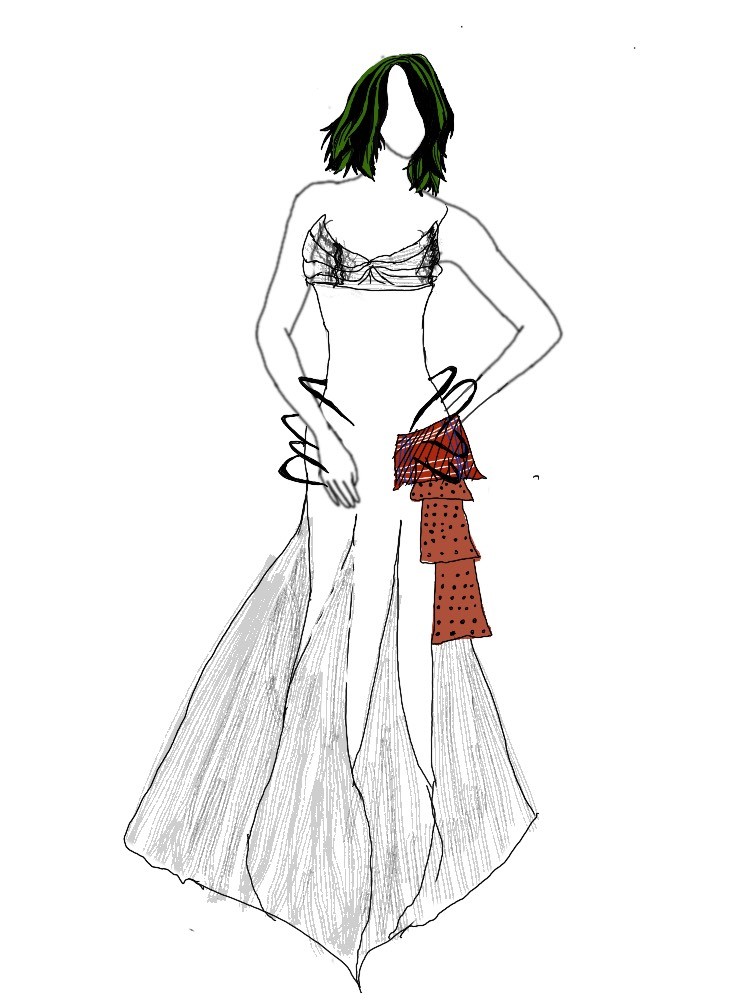
I’ve always thought that Spiders are very beautiful and at the same time very terrifying – which is the basis of the femininity that I wanted to incorporate in some way.
I also chose this animal since it is misjudged by mainly being seen as a disgusting or aggressive animal but it ultimately is a harmless and helpful animal, especially to us humans.
The painting the animal is depicted in, Daddy Longlegs of the Evening–Hope!, is the start of Dalí’s journey to America and a symbol for luck, which spiders are often depicted as.
My materials consist of a variety of donated and thrifted fabrics and textiles. I mainly used bedsheets and pillowcases, which I found were great – as they were much more affordable and had just about the same amount of yardage than getting cloth from a fabric store.
I did end up buying crepe and chiffon for the outermost layers of my dress to ensure that sturdy and clean look!
My process was mainly draping, pleating and hand-sewing. Starting off with drafting the bodice to run down the body rather than stopping at the hips, and ultimately creating small handkerchief skirts that mimic webs, especially with the sheer chiffon material imitating transparent webs.
Elle Orchard
Lobster Telephone, 1936-38
St. Petersburg High School
Grade 12

I selected the Lobster for its symbolic and aesthetic significance. The primary reason is its iconic status in surrealism, brought to life by Dalí and his benefactor, Edward James. This traditional critter embodies the ideas of femininity, pleasure and pain.
The lobster, known for lifelong mating, is considered one of the most romantic animals, with the color red further accentuating this symbolism.
Beyond romance, the lobster represents the cycle of life and death, evident in its transformation to a deep red tone when cooked. The lobster symbolizes strength and protection due to its hard exoskeleton.
In choosing the Lobster, I aimed to encapsulate these rich layers of meaning in my artistic expression.
My gravitation towards the lobster was also influenced by extensive research on Vera Wang and the true meaning behind her red wedding dresses, as well as Sylvia Plath’s confessional poetry addressing the double standards women face in society.
In my pursuit of storytelling through my work, I merged Dalí’s perspective on the lobster with my understanding of these other artists’ works, creating a cohesive narrative that solidified my choice of this intriguing creature.
I’m captivated by Dalí’s unconventional interpretation of the lobster, particularly his pairing of this creature with a telephone in the sculpture Lobster Telephone — a seemingly abnormal yet profound combination.
This juxtaposition underscores Dalí’s belief that unrelated items can be fused to create new meanings. In his surreal world, the lobster’s tail is placed over the telephone’s mouthpiece, a visually striking image challenging conventional associations.
My design aims to not only represent the lobster but encapsulate the female experience. This is manifested through the fierce red satin, the layered tail shaped simultaneously like a female silhouette and lobster tail, and the form-fitting nature.
Similar to Dalí drawing attention to the lobster’s underside meeting the ear during a telephone conversation, I sought to push boundaries with my garment’s overall fit and flow.
The lobster telephone composition introduces the unsettling notion of serving this unconventional duo to someone expecting a traditional seafood platter. It symbolizes the unexpected realities and concealed aspects of a woman, inviting contemplation of hidden complexities beneath seemingly ordinary surfaces. This juxtaposition provides a
thought-provoking commentary on the intersections of reality and imagination.
Inspired by this complexity, I incorporated layers of fabric into my design. These tiers of fabric serve to add thought-provoking texture and introduce the same sense of abnormality that Dalí embraced. Through these layers, I aim to convey a depth of meaning, mirroring the intricate layers of symbolism found in surrealism.
I learned how to sew when I was around six – however, it was not until I was older that I gained the confidence to take on challenging sewing endeavors. My grandma is the sole reason I began to sew. I credit my grandma for showing me the combined power of textiles, imagination, and compassion for others.
In capturing the essence of the lobster’s feminine, glamorous and fierce red color, I chose a vibrant red silk fabric for its striking effect. In the spirit of adaptability and sustainability, I repurposed a red tablecloth to mock up my design first.
The red zipper closure on the side served a practical purpose while allowing the back of the garment to be as impactful as the front. Inspired by the telephone motif, I used wire to provide structural support, mimicking the cord of the telephone around my neck.
The bodice construction involved using embroidery backing to hold the structure of the cups, requiring patience and precision. To enhance the glamorous feel, I adorned the bodice with long beads.
I initiated the design process by sketching out numerous conceptual ideas to come up with my final rendering. I then created a more technical design, including layers, seam lines and closure placements.
Moving on, I focused on draping the bodice pattern on a dress form, particularly honing in on the cup detail. I had to hand-sew the cups before stitching them with my machine due to their organic shape.
The bodice, where I began, required over a month to complete as I hand-draped it and crafted both the lining and outer pieces. To reinforce the delicate silk fabric, I added interfacing and boning on the lining piece.
Following this, I drafted a pattern for the dress bottom based on my measurements, ensuring that the godets laid perfectly for the sleek design I envisioned. The initial mock-up verified the desired shape.
Subsequently, I added the tail of the dress and shoulder details. This intricate process demanded significant time and dedication, involving extensive hand-sewing and meticulous fitting.
Layering the fabric for the train was particularly time-consuming. It took three days alone to layer the fabric for the train, involving hand-sewing gathering stitches and meticulous pinning every centimeter to achieve the desired effect.
The finishing touch was the hand-sewn beads on my bodice cups. Mathematical calculations and careful rationing of fabric were essential to my construction process. Throughout this creative journey, I visualized each step and troubleshooted as needed, navigating the process without specific guidelines or instructions.
Isabel Powers
Paranonia, 1935
Palm Harbor University
Grade 11
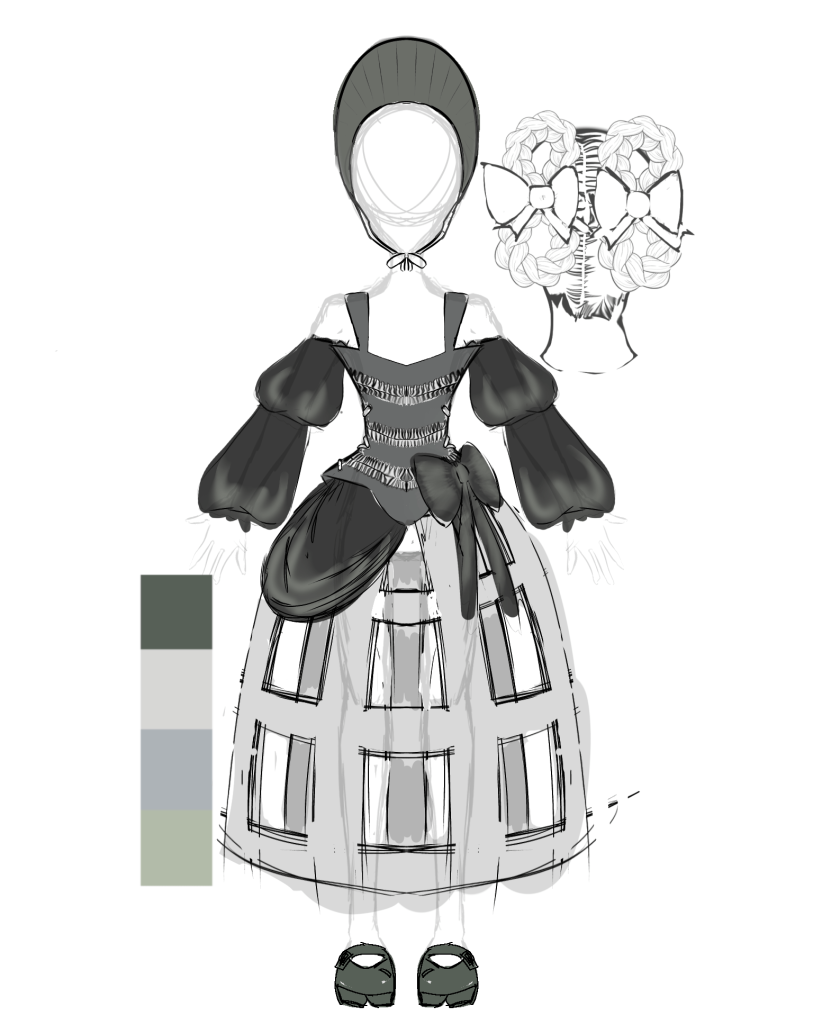
I chose the Horse because they are elegant, graceful and bold, but often overlooked in the modern world despite playing a crucial role in early societies.
Dalí’s painting featuring horses, Paranonia, displayed all three of these aspects, making it one of my top favorites from which I could draw inspiration.
The biggest and most obvious parallel between my work and Dalí’s is the color scheme of cool-toned, low-luminosity hues with a hint of lighter colors, such as gray or silver. Some other representations of his work include the emphasis on the visual aspect of the bust, and transformation of the shadows in Paranonia into asymmetrical details like a single bustle and a single bow.
For materials, I sourced from fabrics that were donated to the program and from thrift stores like Goodwill, while smaller details and products for construction came from both the workshop and retail stores like Joann Fabrics. I also used the internet as a tool through videos about sewing and free online pattern templates to help me along the way.
My process was very much experiment-oriented, revolving around trial and error and seeing what works best versus what doesn’t work as well. While my process was most definitely not close to being professional, it’s been the most helpful tool in learning from my mistakes.

Isolde Rayman-Moore
The Average Bureaucrat, 1930
Hillsborough High School, Tampa
Grade 12
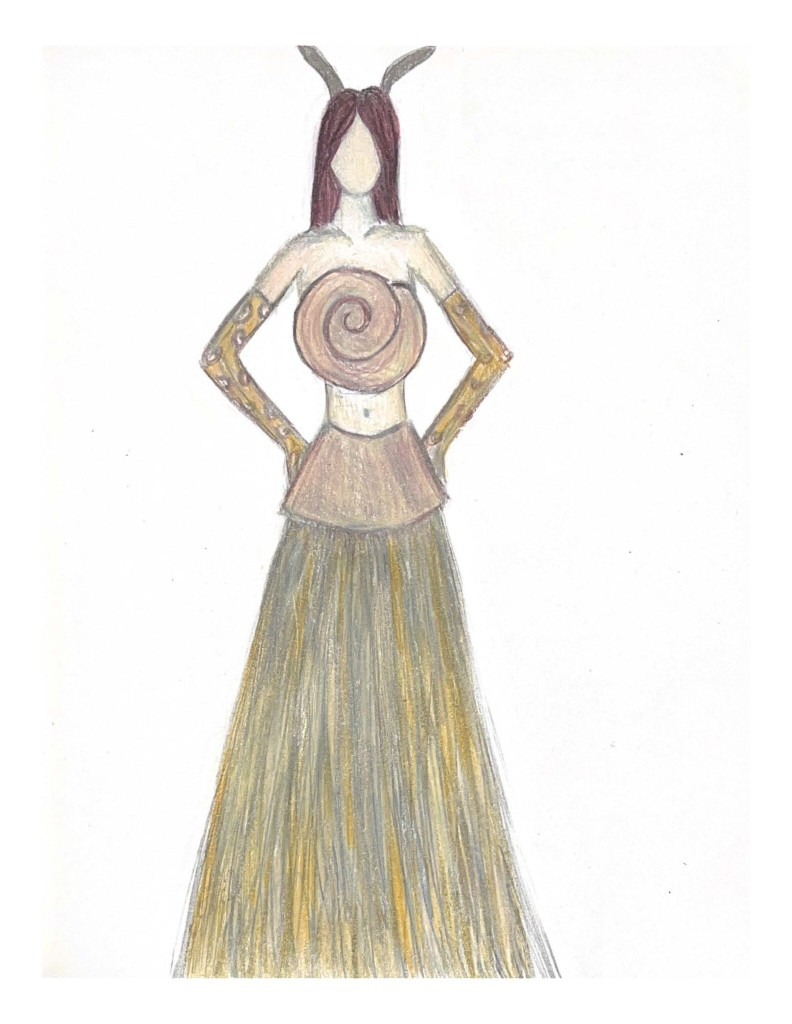
I chose one of the most unpopular animals – a Snail – because even though they are often considered to be gross, their shells are actually very pretty. Despite being found less frequently in art, snails have a lot of recognizable features I could pull from.
The top of my dress has a snail shell made of papier-mâchè and paint. The tulle skirt represents the trail of slime. The miniskirt on top of the tulle is made of glittery fabric.
The meaning of the snails within the ear of Dalí’s painting, The Average Bureaucrat, is that Dalí’s dad doesn’t listen to him – so I’ll cover my model’s ears.
For my designing process, I start by sketching the design over and over again until I figure out what I want it to look like. Then I look at fabrics and try to make a model of it.
Then I redraw the design for how it will logically fit and start making the piece. I sometimes redraw the design up to 20 times.
Rainna Rodgers Spaights
Geopoliticus Child Watching the Birth of the New Man, 1943
Pinellas County Center for the Arts at Gibbs High School, St Pete
Grade 10

I chose a Chicken Egg because eggs are some of my favorite foods to eat – a versatile food that can be cooked in many different ways. I also really like chickens as an animal because they are extremely cute in my opinion and to me they represent innocence.
I gravitated towards the color palette used in Dalí’s painting, Geopoliticus Child Watching the Birth of the New Man. By choosing this painting, I had many different directions I could go with my piece.
My piece mimics the shape of an egg in the skirt and using yellow fabric to represent the yolk. The headpiece represents the uterus located at the top of the painting. The lace on the corset adds a youthful look to match the innocence of a chicken.
My materials consist of random scraps of fabric Ms. Donnelly, Sumaya, and our sponsors provided us with. These scraps are what I used for the sleeves, the blood and other embellishments.
The corset is made of a fabric I found in one of the donation boxes, the boning was bought from an online sewing supplies store, and the lace was seam ripped off a shirt from Goodwill. The skirt is made out of satin and tulle I found at Joann Fabrics and the red fabric on the skirt is from a donation box.

Ellen Russell
Nature Morte Vivante (Still Life—Fast Moving), 1956
H.B. Plant High School, Tampa
Grade 11
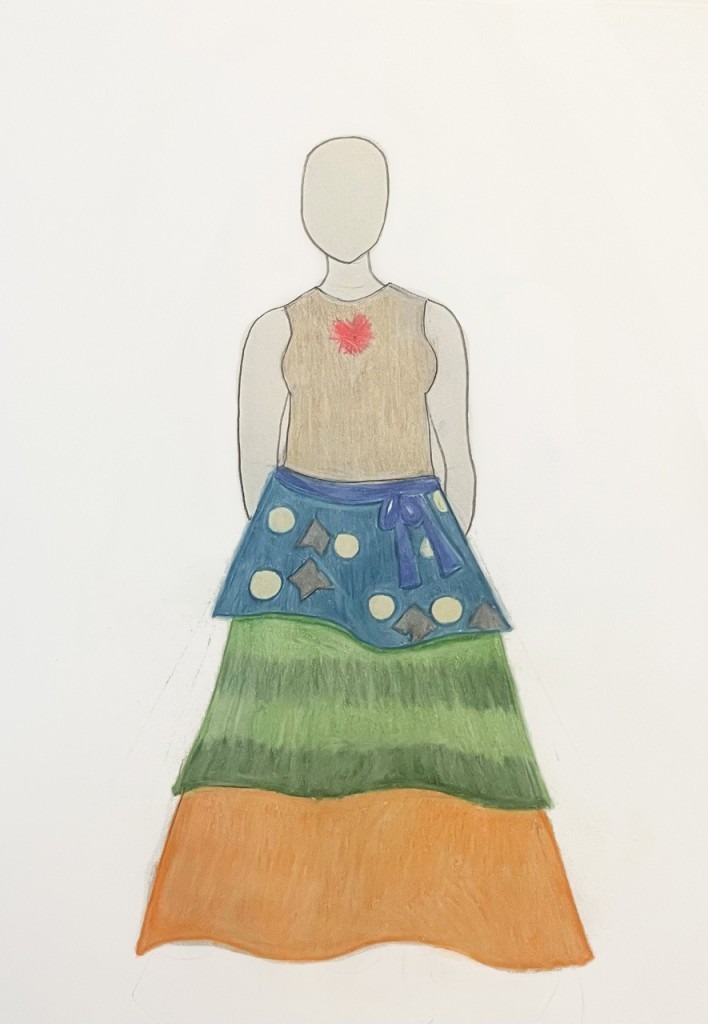
I initially chose the Rhino because of the connection this animal has to strength. After choosing the rhino, I learned about the cultural significance it has around healing properties – as well as the comparison to a unicorn, which symbolizes purity.
All of this broadened my awe for Dalí’s view of these animals.
My piece connects to the rhino/unicorn through the symbolism of the strength of Christ and biblical virtues. The Bible verses that inspired different aspects of my piece are Proverbs 31:25, “she is clothed with strength and dignity and she laughs without fear of the future,” as well as Peter 3:4, “your beauty should not come from outward adornment. . .”
Those verses inspire the virtues part and almost show freedom – represented in these silhouettes. The skirt represents women and Genesis, and the rhino represents God’s strength.
Implicating a bleeding heart was important for me because of the verse, “. . . I will remove your heart of stone and give you a heart of flesh.”
Dalí believed religion could be justified by math and science, as well as perfect symmetry, so using that in the patterns was super important. The skirt, which is a circle, has perfect symmetry.
Dalí found answers through the knowledge a rhino withheld, and I wanted to reverse those ideas by showing how rhinos could signify something bigger.
The materials I used consist of old fabrics from Goodwill, yard sales, old dance costumes, organic fabrics and organic embroidery thread. I wanted to stay true to the message of my piece all the way down to the fabric, coming from the Earth to the model, who was probably the second biggest inspiration for my concept.
My process consisted of going between sketches and a million different ideas, along with a lot of failed constructing and trying to learn new sewing techniques that worked best. When I finally chose an idea and concept, finding the right fabrics was hard – it was a lot of rummaging and settling.
The easiest part was probably the sewing once I finally put my one thousand thoughts to rest.
Kaylee Schauer
Archeological Reminiscence of Millet’s Angelus, 1934
Palmetto Charter School
Grade 8

The animal I chose was the Praying Mantis. I chose this animal so I can show people how Dalí interpreted it differently than most people would. Dalí found the praying mantis particularly special because he believed it related to his wife Gala. She was his muse for many of his works and was the love of his life.
Dalí thought of the praying mantis as female dominance, and thought they could quickly change from pretty to ugly. This shows in my design by dropping the beautiful silky and flowy skirt to reveal the torn-up and bloody tights.
I bought most of my fabric at Goodwill, and the shorts, leggings, tights, and shoes. I got the fabric for the corset at Michaels. I bought the sheer fabric for the train and the sleeves from Jay’s Fabric Store.
My process for designing and constructing my piece was to find fabric that I thought embraced the animal as much as possible.
Violet Schuele
Profanation of the Host, 1930
Osceola Fundamental High School, Largo
Grade 11
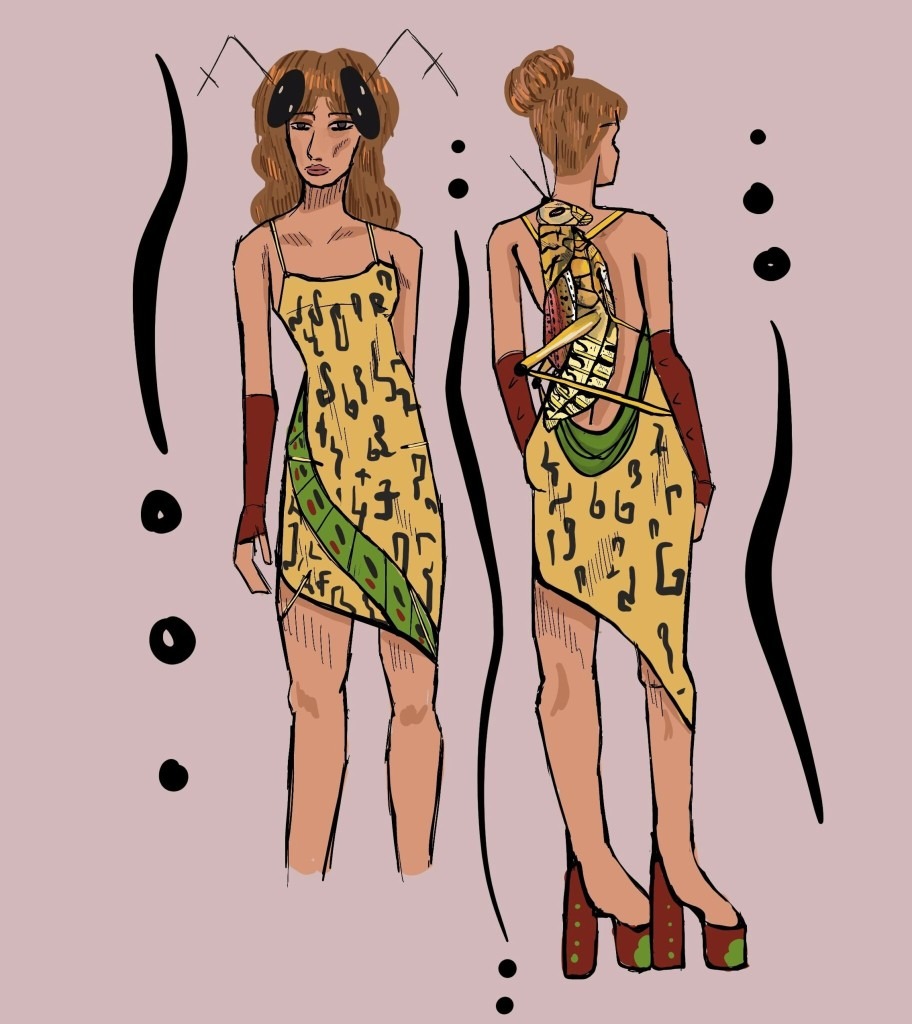
I chose the Grasshopper because Dalí was horridly afraid of them and considered them grotesque. I chose them in order to make a “horror” piece, yet struggled greatly to interpret them as such.
I consider Dalí’s painting Profanation of the Host to be flowy and odd. It incorporates yellow, green and occasional splashes of red. I’m using all these colors to make my piece mellow and not extraordinary, for Dalí’s work is made with a muted palette.
I used Eva foam for the grasshopper on my back, metal for the antennas and EVA foam for the headpiece with clay around it. My dress consists of a satin slip dress underneath, with an overlay dress crafted from a shirt I found at Goodwill that I deconstructed, and fabric given to the program in the donation bin.
The only item I had to pay for was the satin to create the dress, the foam was given to me by a teacher of mine who no longer needed it.
My process is complex! I’m working with a fabric I’m not used to, and EVA foam, which I’ve never used before. I’m a relatively new to sewing and I’m trying a lot of new things, which is very hard!
Lauren Shadrick
The Hallucinogenic Toreador, 1969-70
Homeschool
Grade 10
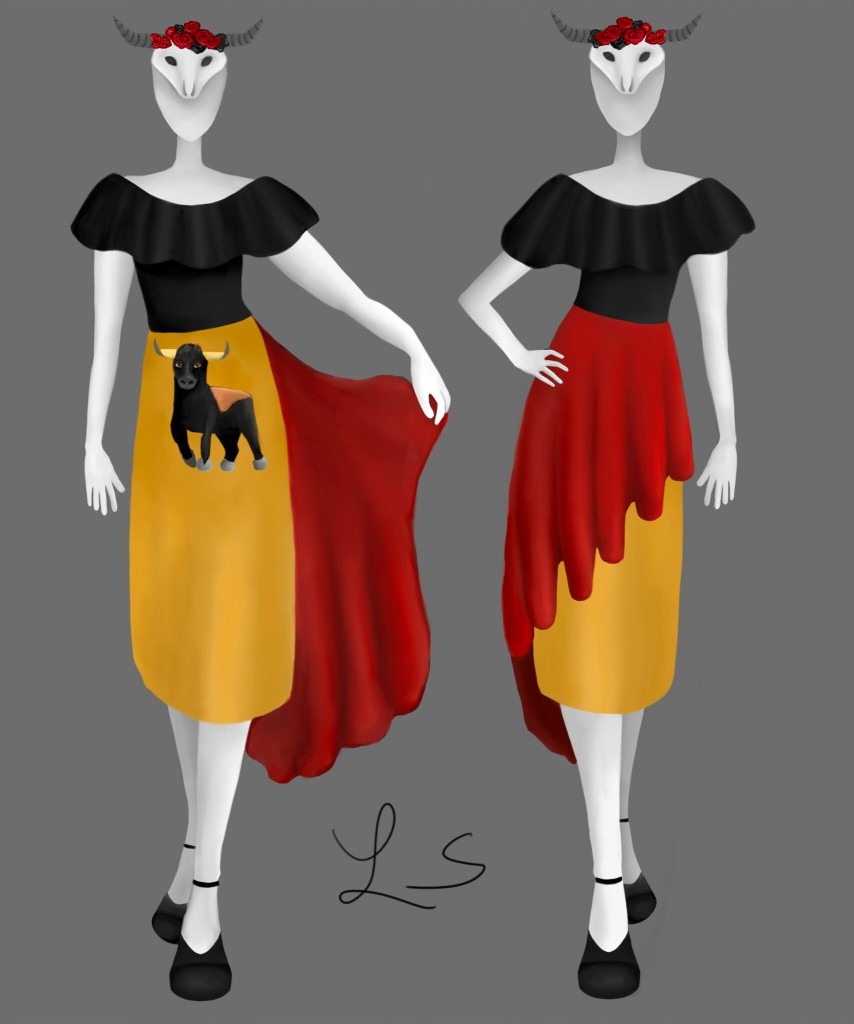
The main reason I chose my animal, the Bull, is because of its horns. The symbolism of the bull also contributed to my decision. I’m intrigued by bullfighting and how prominent it was in Spanish culture.
I incorporated a bull’s horns and skull into a headpiece with red and black flowers inspired by both Venus and the flowers in Dalí’s painting The Hallucinogenic Toreador to represent femininity. I used black flowers to represent death.
I also created a detachable red skirt to represent a muleta used to guide the bull in bullfighting. Underneath the detachable skirt, I painted a bull and used red and yellow in my color palette, the colors of Spain’s flag.
I drew inspiration from the traje de flamenca, or flamenco dress worn for dancing, because of the flamboyant ruffles and bold colors. Because of that, I added lots of ruffles to my design and used a silky, bright red fabric to create an eye-catching effect.
My materials include old T-shirts, aluminum foil, papier-mâché, clay, store-bought fabric, floral bouquets and acrylic paint.
First, I started shaping my headpiece with aluminum foil to form horns and a bull skull, then added papier-mâché to keep it light. After that dried, I applied a layer of gesso, sanded it down, painted it with acrylics, and glued black and red roses to the top.
Next, I repurposed two black shirts and used one to create ruffles on top of the other shirt. Finally, I painted a bull on yellow fabric that I bought, sewed my red skirt, and attached it with Velcro.
Originally, it was difficult to visualize my design – but once I started doing research on Spanish culture and analyzing the bull’s exterior, I knew I wanted to create a headpiece with horns and a bull’s skull.
Once the headpiece was designed, I brainstormed on the top and knew I wanted a simple black ruffle top that could be accented with anything to save time.
Once I finalized my rendering, it helped me visualize the rest. I envisioned painting a bull on the first layer of my skirt, covered with a red ruffle skirt, with Velcro to later reveal the painting underneath.
Originally published on the Dalí Museum’s website
– you can read the full story here.
You can explore the work created by emerging
designers in previous years here.

